- Hotline+971 50 27 28 29 1
- for Individual offices click here
STA's Team of Lawyers in Abu Dhabi, Bahrain, Doha, UAE, Luxembourg, Moscow, RAK, Sharjah, and Singapore. Find a Lawyer. ..
Read more informationPerspectives on Copyright, Fair Use, and Industry Implications in Google v. Oracle
 The Supreme Court of the United States, putting an end to a decade-long copyright dispute between Google and Oracle, ruled that Google's copying of the Java programming language was not illegal.
The Supreme Court of the United States, putting an end to a decade-long copyright dispute between Google and Oracle, ruled that Google's copying of the Java programming language was not illegal.
The court (6:2) noted that the API only contained the lines of code required to enable programmers to apply their skills to a new and revolutionary program. Oracle had filed a copyright infringement lawsuit against Google in 2010 over the copied computer code. The Federal Circuit Court ruled in Oracle's favour, prompting Google to appeal to the Supreme Court.
The court began by assuming that the entire Sun Java API falls within the scope of what can be copyrighted, and then considered whether Google's use of a portion of that API was a "fair use." The Court looked at the four factors mentioned in the fair use clause of the Copyright Act: the essence of the copyrighted work; the intent and character of the use; the size and significance of the component used in comparison to the entire copyrighted work; and the effect of the use on the potential market
"Google copied about 11,500 lines of declaring code from the API, which is nearly all of the declaring code needed to call up hundreds of different tasks." However, those 11,500 lines make up just 0.4 percent of the API in question, which has a total of 2.86 million lines.
The 11,500 lines of code should be regarded as a small part of a much larger whole when considering "the volume and substantiality of the portion used" in this case. The copied lines of code are inextricably linked to other lines of code that programmers can access as part of an interface. These lines were copied by Google not because they were clever or beautiful, but because they would enable programmers to apply their knowledge to a modern smartphone computing world. "Where, as here, the amount of copying was tethered to a legitimate, and transformative, intent, the "substantiality" factor would generally weigh in favour of fair use," the court said.
When overturning the Federal Circuit's decision in favour of Oracle (that the section is copyrightable and Google's copying was not a "fair use"), the court noted:
Since computer programs are largely functional, conventional copyright concepts are difficult to implement in the technical environment. The Court concludes that Google's copying of the API to re-implement a user interface, taking only what was required to enable users to put their accumulated talents to work in a new and revolutionary program, constituted a fair use of that material as a matter of law, applying the standards of the Court's precedents and Congress' codification of the fair use doctrine to the distinct copyrighted work here. The Court does not revoke or change its previous decisions concerning fair use in drawing this conclusion.
 The court also stated that Google copied only what was required to enable programmers to work in a new computing environment without having to abandon a portion of a well-known programming language. "Google's goal was to develop a new task-related framework for a new computing world (smartphones), as well as a platform—the Android platform—to support and popularize that goal. The evidence shows that incorporating an interface will aid in the creation of computer programs in a variety of ways. "Google's goal was therefore compatible with the artistic innovation that is the fundamental constitutional goal of copyright," it said.
The court also stated that Google copied only what was required to enable programmers to work in a new computing environment without having to abandon a portion of a well-known programming language. "Google's goal was to develop a new task-related framework for a new computing world (smartphones), as well as a platform—the Android platform—to support and popularize that goal. The evidence shows that incorporating an interface will aid in the creation of computer programs in a variety of ways. "Google's goal was therefore compatible with the artistic innovation that is the fundamental constitutional goal of copyright," it said.
In his dissent, Justice Thomas stated that three of the four statutory fair-use considerations weigh heavily against Google. Since holding otherwise would unlawfully circumvent Congress' decision that code is copyrightable, the existence of the copyrighted work—the sole factor potentially benefiting Google—cannot by itself justify a determination of fair use, the judge said.